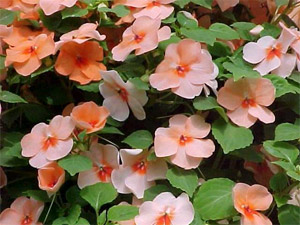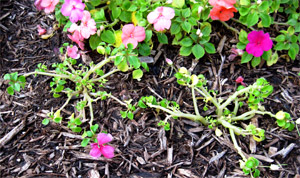The Low-Down on Downy Mildew
In the past few weeks I’ve had a plethora of questions come to me through my website with the same theme: what is going on with impatiens? And so, I’ll lay it out for you here to help you understand the situation.
Impatiens
While most of you have a good idea of what an impatiens is, some may not. Impatiens is a flowering plant in the Balsaminaceae family. There are between 850 and 1,000 species of impatiens throughout the Northern Hemisphere and the tropics but in Canada, we are most familiar with Impatiens walleriana.

The Problem
Within the past few years, a fungal disease called downy mildew moved from Europe to Florida and has since been moving north. Last year Canadian gardeners started to notice it moving through their impatiens. Unfortunately, the spore is now readily found throughout Canada so even buying healthy-looking impatiens will not be enough.
Downy Mildew
Scientifically speaking it is a fungus caused by an organism known as Plasmopara obducens and it causes several very obvious symptoms: yellowing leaves and a grey-white powdery looking film on their underside. Once the organism has settled in for good, the leaves will drop and continue to drop until you are left with a naked stem.

The Good News
Plasmopara obducens only affects Impatiens walleriana so other types (your New Guinea impatiens, for example) will be fine.
What You Can Do
This year and perhaps in the following few years, I would avoid buying any walleriana type impatiens. This is going to save you time, money, and the visual disaster that the mildew will bring to your impatiens.
There are a number of beautiful New Guinea impatiens (Impatiens hawkeri) that will perform very well in your garden where walleriana may have been last year.
If you absolutely must have Impatiens walleriana, know that there are no fungicides available to you as a homeowner. You can, however, try this:
1. New soil in a clean pot: soapy water with a drop of bleach kind of clean.
2. Keep leaves and flowers dry: water from the bottom.
3. Give them space: good air circulation will help keep leaves dry.
4. Pick off and dispose of any infected leaves. Not to be disposed of in the composter but, sadly, the material must be burned or put out to the curb.
And one last word: there are so many beautiful, easy-to-grow plants out there; there really is no need to plant Impatiens walleriana this year or the next. Try something new: your garden will thank you for it.



